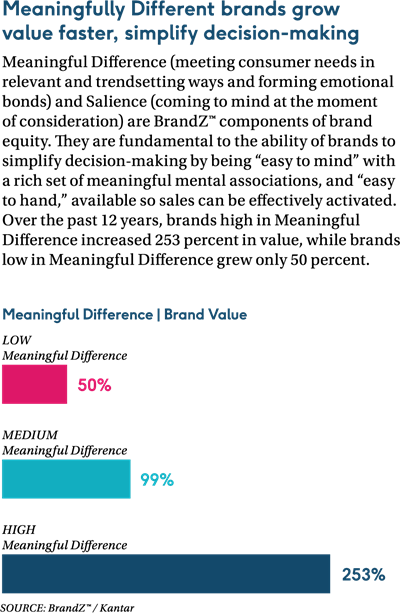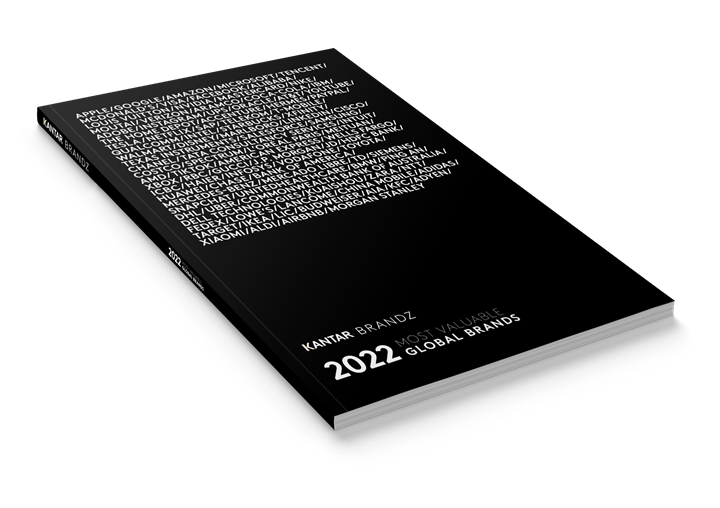Note: This article is part of a collection of brand-building and thought leadership articles from our report on the BrandZ Top 100 Most Valuable Global Brands 2020.
Brands facing the disruptive consequences of COVID-19 need to anticipate a multi-dimensional hangover that includes consumer uncertainty about the economy and spending, health and hygiene, and socialising, according to Kantar’s COVID-19 Barometer. BrandZ™ analysis of brand recovery since the financial crisis adds an important context for navigating this uncertainty. Brands mattered during the financial crisis recovery. They matter today. They will matter as global economies reopen and people begin to reclaim their everyday lives. Brand strength adds resilience because it offers reassurance to buyers. In good times, strong brands grow value faster. In tough times strong brands recover faster.
Brand performance over the past decade provides measurable proof. The stock prices of the BrandZ™ Powerful Brands Top 10 Portfolio, the global brands highest in brand equity, rebounded almost immediately after the market crash and began climbing in shareholder value, even as the S&P continued to plateau for several years. Between 2006 and 2020, the BrandZ™ Powerful Brands Top 10 Portfolio increased 285.2% in value, while the S&P rose only 120%. With category-specific fluctuations, the upward trajectory is consistent across most of the economy. Fast food and technology emerged quickly from the global financial crisis, for example, and are likely to demonstrate strength again because strong brands, often enabled by digital innovation, have provided the products and services that meet people’s needs in meaningful ways. Only one category, cars, has not rebounded. Because of category structural changes—changing attitudes about mobility, ownership, and protecting the environment—the car category has not regained value lost during the global financial crisis. Individual car brands have gained, however. The most disruptive car brand, Tesla, achieved the greatest value increase.

Short-term imperatives
Brands did not recover automatically after the financial crisis. And they will not recover automatically from this crisis. Understandably, during a period of uncertainty and financial pressure, it is tempting to cut back on advertising and marketing investment, at least short-term. But cutting back is counter-productive. The need to feel comfortable and certain about the market before investing is normal. But today is not normal. Waiting to invest will not add comfort or certainty, but it will jeopardise effectiveness. Brands need to come easily to mind and be easily accessible. Disappearing from the marketplace to gain a short-term financial benefit will make it more difficult and expensive to rebuild brand presence.
It may not be possible to always be physically present, to have certain products available all the time. People are becoming accustomed to shortages. Mental availability is possible, however, and it is critical. Brands that continue to advertise reduce the risk of future market share loss. If it is necessary to reduce a product range because of slackening demand, then it is best to focus on the parts of the range that best represent the core brand purpose and do not compromise core positioning and values. It is important to focus on salience, reach, search, distribution and pricing. Although it is impossible to predict exactly how the pandemic will unfold, COVID-19 is likely to cycle in and out of our lives well into 2021, according to Kantar’s COVID-19 Barometer. Navigating through this disruption, Meaningful Difference, the principal BrandZ™ component of brand equity, remains critical for short-term recovery and long-term brand value growth.
One indicator of the impact of Meaningful Difference is its correlation with stock market performance. Over the past 12 years, the BrandZ™ Global Top 100 brands with the highest scores in the BrandZ™ Meaningful Difference Index grew five times faster in value than the brands that scored lowest. The key question becomes, how does a brand achieve Meaningful Difference, especially in periods of disruption? BrandZ™ has developed five Vital Signs that underpin Meaningful Difference. The five Vital Signs work progressively, starting with Purpose (a brand’s reason for being, the way it makes people’s lives better); Innovation (the way a brand implements its Purpose with leadership, creativity, and disruption); Communications (the way a brand gets the word out about its innovations); Brand Experience (how a brand makes people feel), and Love (customer affinity for a brand, an outcome of the other four Vital Signs).
Long-term prescriptions
Brand Purpose
All brands have particular areas of prowess and competence. Brands need to harness these areas of expertise to deliver their purpose in meaningful ways that benefit people. In the current pandemic context, medical and health expertise would be especially important, but lack of relevant expertise is not an excuse for not making a contribution, even a financial one. Brand response should embrace consumers, customers, society at large, and employees as well as partners in the supply chain. Clearly, times of crisis should not be exploited for the benefit of a company’s bottom line, but a well coordinated response may trickle down to positive brand associations in the medium-to-long-term.
BrewDog, a UK drinks brand repurposed its production to make hand sanitizer, and it created online virtual bars to encourage socialising with social distancing. BrewDog scores high on all BrandZ™ indices of social responsibility. In customer care, for example, BrewDog scores 120 on a scale where an average score is 100. Brands need to be consistent and sincere. For brands with purposeful values at the core of their positioning, a crisis is a critical time to deliver on those values with action—failure to do so is likely to have a damaging effect.
Innovation
Even in difficult times, true innovators do not stop innovating. They adapt to a changing environment and meet emerging consumer needs. And they continue to invest in R&D as much as possible to maintain relevance both during a crisis and beyond. Brands need to consider how their service or product offer could be enhanced and upgraded in a directly helpful and constructive way for the benefit of its customers. Creative solutions are not limited to advances in functionality and product design. Changes to usual rules of engagement and modes of operation may result in much-needed assistance, not quickly forgotten.
AIA, a leading Asian insurer, launched a free COVID-19 coverage in Singapore, for example. Not only did the brand score 113 on the BrandZ™ Innovation Index, but scores in the BrandZ™ Indices for social responsibility and customer care reached 125 and 122, respectively. The average is 100.
Communication
It is vital to maintain share of voice, if at all possible. Experience proves that an increase in marketing pressure during economic difficulty can bring advantages in the long term. Brands need to evolve and tailor existing content and media planning with a relevant message, or make existing assets work harder by prioritising the most effective, while ensuring that their focus remains suitable. Being playful in a crisis is a double-edged sword. It can provide refreshing respite, but it also has the potential to cause offense. If pursuing humorous or light-hearted content, particularly if directly related to COVID-19, make certain that the content fits well with the brand heritage and style.
For example, Nando’s, a South African restaurant chain specialising in chicken, scores 140 in Rebellious and 130 in Creativity, well over the average score of 100 in these BrandZ™ personality indices. In a humorous public service effort encouraging people to practice social distancing, Nando’s referenced its competitor KFC with a tagline asserting, “Turns out, finger licking good isn’t good.”
Experience
Experience drives the strongest mental associations vital to brand equity. It is important to mitigate service disruptions and focus on the customer to learn what elements can be improved. Reliable standards become even more important as consumers seek reassurance through service and may be unable to replace or upgrade products as easily as before. Brands must uphold standards as far as is possible in order to prevent softening confidence.
Amazon was well-positioned when physical stores closed, and shopping shifted online. The spike in home delivery demand slowed Amazon service during the height of the pandemic, but the e-commerce giant explained that it needed to prioritise key supplies. Amazon educated its virtual voice assistant, Alexa, to answer diagnostic questions about COVID-19.
With people quarantined and airlines mostly grounded, Airbnb and Tripadvisor helped people enjoy the experience of travel by providing online virtual tours. As these examples illustrate, there is an opportunity for brands to be inventive delivering services or experience. Brands should think about which specific aspects of existing experience need to be dialed up or down to make lives easier— particularly for existing customers.
Love
Brands with existing emotional connections can provide moments of relief and calm during a period of stress. Helping with relevant suggestions, recommendations, guidance and even just staying in touch—without needlessly imposing—is likely to be appreciated if done with genuine concern for customers.
Among the many brands that introduced helpful initiatives during the pandemic, the Indonesian-based ride-hailing app Gojek supplied ride vouchers to healthcare and other frontline workers, in a program called GoHeros. Against an average score of 100, Gojeck scores 128 on the BrandZ™ Love Index.
Trusted brands evoking national or community pride have a unique opportunity to make a difference with inspirational action. Behavior needs to be genuinely altruistic, which suggests focusing more on the activity and less on the surrounding public relations. Mobilising resources to bring a practical edge to a brand’s existing strong emotional connection is likely to have a memorable benefit in this moment of uncertainty.
For more perspectives and insight like this, check out the BrandZ Top 100 Most Valuable Global Brands 2020 report.



